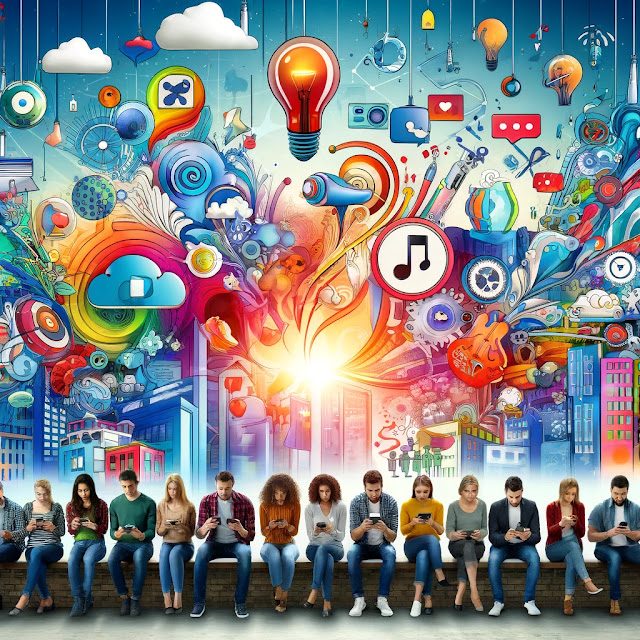Converging Paths: The Fusion of Art, Science, and Technology
In the early days of photography, for instance, artists who were also skilled in chemistry and optics played crucial roles in advancing the medium. Their experiments were not just artistic but also technical, contributing to the evolution of photographic techniques. Similarly, the development of cinema, sound recording, and even electrical lighting involved artists who often acted as inventors and technicians.
This crossover tradition has a deep historical root, stretching back to the Bauhaus movement, where artists sought to integrate their work with industrial technologies, and the Futurists, who celebrated modern technology's mechanical and dynamic qualities. Even the Dadaists, known for their ironic and critical stance towards societal norms, engaged with technology to subvert and redefine artistic expression.
New technologies present unparalleled opportunities, transforming once fantastical ideas into tangible possibilities. Explore the depths of human consciousness and physicality. Modify your gender or physique, incorporate bionic enhancements, replicate yourself, engineer new life forms, boost cognitive abilities, sexual desire, longevity, emotional well-being, and more. If these advancements can be pursued for scientific, entertainment, or commercial purposes, why not for artistic expression?
Several contemporary initiatives aim to integrate art with research, showcasing various roles for artists, ranging from leading the efforts to providing consultation on externally initiated projects. Below are a few examples:
Xerox’s PARC Artist-in-Residence Program (PAIR): Initiated by Xerox's PARC, the PAIR program fostered collaboration between artists and researchers. Participants co-defined problems and solutions, making the definition process a part of the artistic collaboration. Their experiences and outcomes are documented in "Art and Innovation," edited by Craig Harris.
Banff Centre for the Arts: For many years, this center has hosted innovative artist residencies that allow artists to explore the latest technologies. Located in a mountainous setting, it offers technical support and fosters a community that encourages critical engagement. The center frequently brings together tech innovators, artists, and theorists to delve into areas like Emotional Computing.
Interval Research: This organization included artistic collaboration as part of its research initiatives. Its New Media Experiments program supported artists in exploring emerging technologies, leading to the production of award-winning works that blended art with new tech.
ART+COM: Established in 1988 in Germany, ART+COM focuses on integrating computer technology, communication, and design. It serves as a creative hub where artists, scientists, and industry professionals come together to fuse their ideas and goals, pushing the boundaries of what can be achieved through collaborative innovation.
F.A.B.R.I.CATORS: Based in Italy, F.A.B.R.I.CATORS specializes in merging art and technology to design and produce interactive art pieces, multimedia projects, VR installations, and creative interfaces. Their work is characterized by the integration of multiple disciplines including technology, architecture, and design, promoting a multidisciplinary approach to art and innovation.
These intersections show that the boundary between art and science is permeable and fertile ground for creativity. By exploring and manipulating new technologies, artists have continually expanded the expressive possibilities of their mediums, often leading to new forms of art that challenge and enrich our understanding of technology and its impact on society.
While it is undeniable that both artists and scientists are influenced by their cultural and economic surroundings, I am continuously impressed and motivated by the innovative strides taken by inventors, scientists, and artists. I believe there is great value in working alongside data scientists who have expertise in Artificial Intelligence (AI). The advancements in machine learning indicate that we are nearing the creation of tools that could greatly improve human cognitive functions and potentially outperform them in creative endeavors. This presents AI with the ultimate challenge of replicating and enhancing the creative capabilities of the human mind.
By fully embracing artificial intelligence, writers can expand the boundaries of traditional creativity by utilizing AI as a collaborative partner in the creative process. This approach entails close cooperation with AI specialists to enhance artificially driven creativity, a concept that is still emerging but has been demonstrated in several studies.
A successful collaborative model offers reciprocal advantages akin to the partnerships mentioned above. To engage with the AI community, writers should acquaint themselves with the resources utilized by scientists and engineers, including academic and professional journals, trade shows, academic conferences, online resources, and equipment suppliers. They must be willing to explore unconventional literary formats and present their work in innovative contexts that may diverge from traditional practices. This strategy will empower writers to make distinctive and meaningful contributions to the realm of artificial intelligence, utilizing their artistic insights to enhance technological progress.
Frank Oppenheimer, the scientist who established the world famous Exploratorium museum of science and art in San Francisco explained the rationale for this combination:
Art is included, not just to make things pretty . . . but primarily because artists make different kinds of discoveries about nature than do physicists or biologists. They also rely on a different basis for decision-making while creating their exhibits. But both artists and scientists help us notice and appreciate things in nature that we had learned to ignore or hadn’t been taught to see. Both art and science are needed to fully understand nature and its effects on people.




Comments
Post a Comment